Are your email open rates and conversions not meeting your expectations? Do you find it hard to craft compelling subject lines to attract leads? Lead nurturing emails will help you build strong relationships and guide your leads so you avoid missing out on opportunities.
This guide comes with practical steps and email examples to help you build a long-term relationship with your potential customers. By the end of this read, you will know how to design lead nurturing emails to make your brand top-of-mind and convert prospects into customers.
Let’s get into it.
What Is A Lead Nurturing Email?
A lead nurturing email is a targeted and personalized message that you send to potential customers to:
- Build customer relationships
- Guide customers through the buyer’s journey
Your goal is to educate, inform, and engage leads so that they move closer to making a purchase.
The key characteristics of lead nurturing emails are:
- Build trust and credibility with the lead over time.
- Sent at intervals to engage leads without overwhelming them.
- Tailored to the recipient’s interests, behaviors, and stage in the buying process.
- Offers valuable content like educational resources, product information, or solutions to specific problems.
- Guides the lead to take the next step, whether downloading a resource, attending a webinar, or scheduling a demo.
7 Steps To Create Effective Lead Nurturing Emails
Businesses that excel at lead nurturing generate 50% more sales-ready leads at a 33% lower cost. As you go through each step, pay close attention to specific strategies and understand how you can implement them based on your goals.
1. Slice & Dice Your Lead Pool
Segmented emails have an open rate of 94%. Divide your potential customers into smaller groups based on shared characteristics to make your emails more relevant and effective.
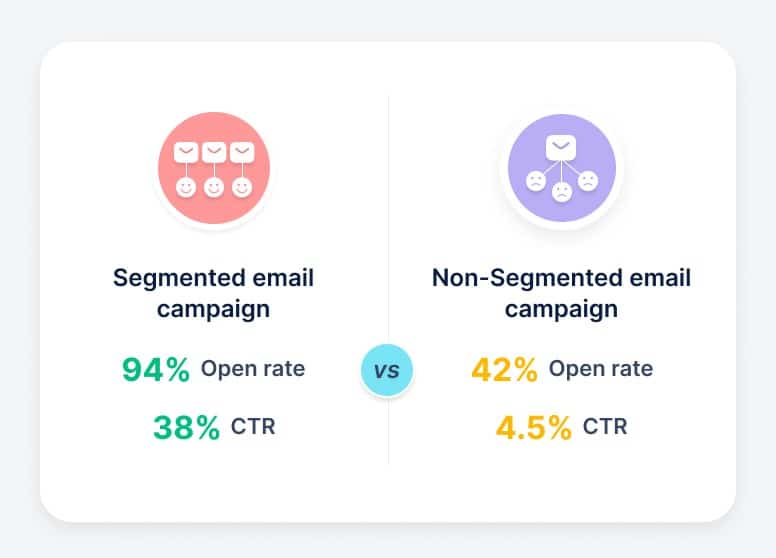
Use these 4 steps to segment your email list:
1.1 Collect Data
Gather information about your leads like their interests, behaviors, and demographics using customer surveys, website analytics, and CRM software.
1.2 Identify Criteria
Determine the criteria you want to use for segmentation like:
- Demographics: Age, gender, location, job title
- Behavior: Website activity, email engagement, purchase history
- Stage in the Buyer’s Journey: Awareness, consideration, decision
1.3 Create Segments
Use the collected data to group your leads into segments. For example, you might have a segment for new leads who just signed up for your newsletter and another for those who have shown interest in a specific product.
1.4 Tailor Your Content
Develop email content that speaks directly to the needs and interests of each segment. For instance, send beginner-level content to new leads and more detailed, product-specific information to leads further down the sales funnel.
A great example is this window cleaning company that uses discounts to target different customer journey stages. For new leads at the top of the funnel, they offer a 50% discount on the first power cleaning service. Big initial discounts make converting a no-brainer, see if you can afford to offer that too.
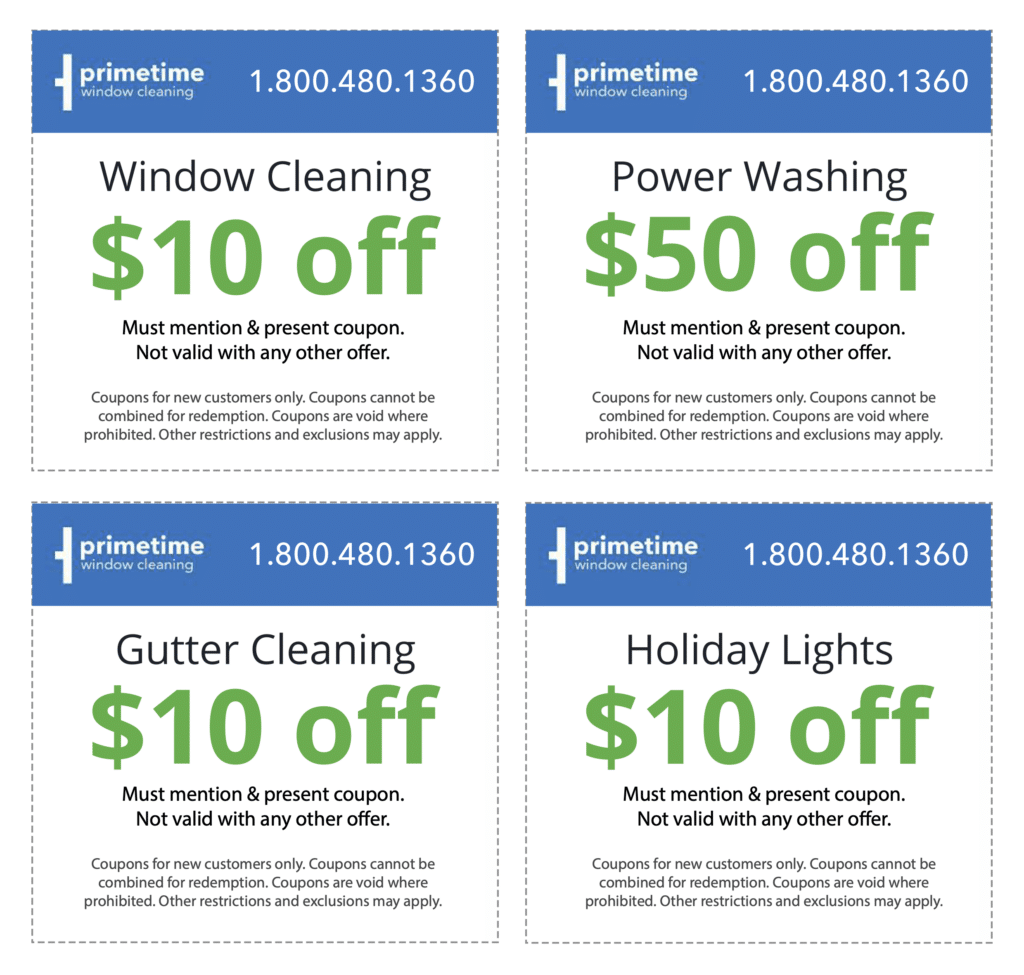
2. Create Subject Lines That Hook Your Readers
47% of people open an email based only on the subject line and emails with personalized subject lines are also 26% more likely to be opened. As your subject line is the first thing recipients see, make it attention-grabbing with these 6 strategies:
- Make sure your subject line tells the reader what the email is about. Also, avoid vague or misleading phrases. For example, instead of “Check This Out,” use “Discover Our New Product Features.”
- Use strong, action-oriented verbs. For example, “Download Your Free Guide” is more engaging than “Free Guide Inside.”
- Hint at something exciting inside the email to grab attention. For example, “Unlock the Secret to Boosting Sales” can make readers want to know more.
- Include the recipient’s name or something specific to them in the subject line. For example, “John, Here’s Your Special Offer”.
- Aim for subject lines that are 6-10 words long to make sure they are fully visible on most devices, especially mobile phones. For example, “Get 20% Off Your Next Purchase”.
- Numbers can make your subject lines more specific and attention-grabbing. For example, “5 Tips to Improve Your Email Marketing” stands out more than “Improve Your Email Marketing Campaigns.”
An excellent example is CoSchedule’s subject line “Hot Summer Deals End Today!” because it creates urgency and excitement. The time-sensitive nature compels the recipients to open the email to avoid missing out on limited-time deals.

3. Craft Emails That Speak Directly To Your Readers
Personalized emails can increase transaction rates by 6x compared to non-personalized ones. So, tailor your content to each recipient so that they feel valued and understood. Follow the 7 proven strategies to make your audience feel connected to your brand:
3.1 Build Connection From The Start
Start your email with the recipient’s name. Instead of “Dear Customer,” say “Hi John.” to make your email more personal and engaging.
3.2 Reference Past Interactions
Mention any previous interactions or purchases the recipient made. For example, say, “We hope you’re enjoying your new laptop” or “Thanks for attending our webinar last week.” This shows you remember their actions and appreciate their engagement.
3.3 Recommend Relevant Products
Use data on past purchases or browsing behavior to suggest products or services they might like to increase your chances of making more sales. For example, “Based on your recent purchase, you might like these accessories.”
3.4 Customize Content
Tailor the email content to match the recipient’s preferences and needs. If you know a lead is interested in home improvement, send them guides on DIY projects, tips for choosing the best materials, or discounts on your home improvement services.
3.5 Send Birthday Or Anniversary Emails
Acknowledge important dates like birthdays or anniversaries with personalized emails. For example, “Happy Birthday, Sarah! Enjoy a special discount just for you.”
3.6 Personalize The Sender’s Name
Use a real person’s name and email address in the sender field, instead of a generic company email. For example, “Jane from YourCompany” feels more personal and trustworthy than “noreply@yourcompany.com.”
3.7 Dynamic Content
Use email marketing tools to insert dynamic content based on the recipient’s data. This means different recipients might see different images, text, or offers in the same email template. For example, show different product recommendations based on their browsing history.
Use Hyperise to personalize images and text within your emails. For instance, if a recipient has browsed fitness equipment, Hyperise can automatically insert images of your latest treadmills and a special discount on workout gear tailored to their interests.
4. Attract Prospects With Valuable Content
To create content that resonates with your audience, you need to understand their needs, pain points, and interests. Here are 5 strategies to help you guide them through the buyer’s journey:
- Create and share educational content that helps your leads learn something new. This can include blog posts, eBooks, whitepapers, webinars, and how-to guides. For example, if you’re a SaaS company, send best practice guides and whitepapers about your software to your email list.
- Back up your content with relevant data and research. Include statistics, case studies, and industry reports to make your content more credible.
- Create lead nurturing emails using a mix of content formats to keep them interesting. This can include videos, infographics, and interactive content using Hyperise.
- Solve specific problems that your leads face. When you address their pain points directly, your content becomes more valuable. For example, a financial advisor could send tips on managing finances during economic uncertainty.
- Make sure your content is relevant to the current trends and timely. For instance, during tax season, an accountant might send tips on maximizing tax returns.
5. Inspire Clicks With Strong CTAs (Calls to Action)
Use clear calls to action (CTAs) in your lead nurturing emails to guide your recipients to the next step in their buying journey. These 5 strategies will help you design an action-oriented CTA:
- Make your CTA specific and action-oriented. Instead of vague phrases like “Click Here,” use clear instructions like “Download Your Free Guide” or “Sign Up for the Webinar.” This tells your recipients exactly what they will get by taking action.
- Create a sense of urgency for your readers. Use phrases like “Limited Time Offer,” “Register Now,” or “Only a Few Spots Left” to motivate your leads to act quickly.
- Start your CTA with strong action verbs to make it more compelling. Words like “Get,” “Download,” “Register,” “Start,” or “Join” will make your CTAs more powerful and engaging. For example, “Get Your Free Trial” is more motivating than just “Free Trial.”
- Design your CTA to stand out visually in your email. Use contrasting colors, bold text, or buttons to make sure your CTA catches the reader’s eye.
- Highlight the value or benefit of taking action in your CTA. For example, CoSchedule’s email CTA “Optimize My Marketing with AI” clearly conveys the advantage of using AI tools for better marketing.
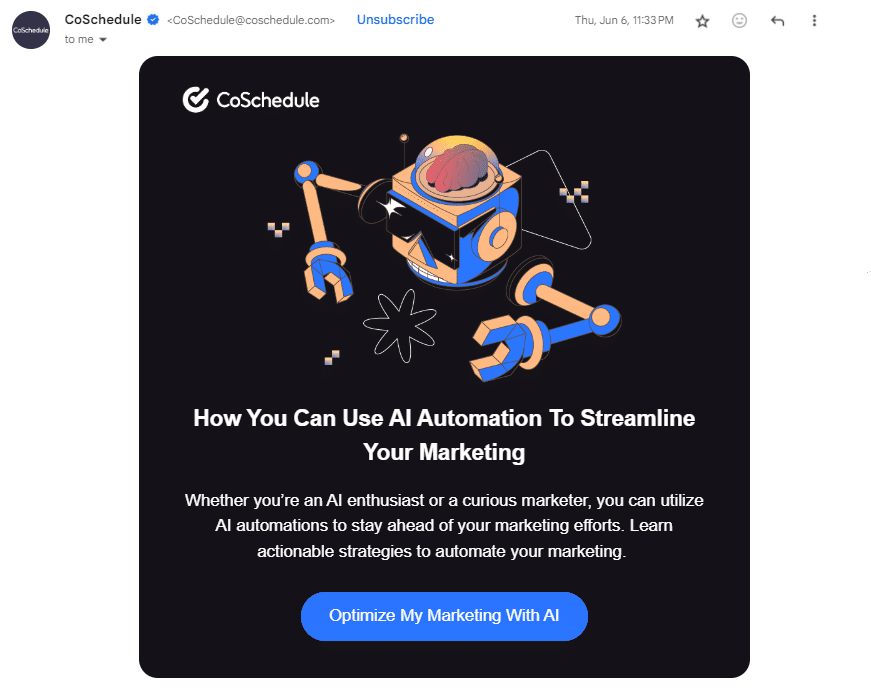
6. Optimize Campaigns With Smart Automation
They ensure you communicate with your leads timely and consistently to nurture them without manual effort. The best part, automation will save time, boost efficiency, and let you deliver personalized experiences at scale. Follow these 4 steps to optimize your email automation:
6.1 Choose The Right Tools
Select a reliable email marketing automation tool from any in the list:
- Mailchimp: Ideal for beginners, with easy-to-use features for automating emails.
- HubSpot: Comprehensive CRM with advanced automation capabilities.
- ActiveCampaign: Known for its powerful automation workflows and segmentation.
- increases your chances of making more sales: Offers budget-friendly automation for lead nurture campaigns.
- Marketo: Advanced platform suitable for larger businesses with complex needs.
6.2 Set Up Drip Campaigns
Drip campaigns or lead nurturing email sequences are an automated series of emails that are sent when your lead takes action. For example, when someone signs up for your newsletter, they automatically receive a welcome email followed by a series of educational emails over the next few weeks.
It keeps your leads engaged without requiring manual intervention.
6.3 Use Behavioral Triggers
Automate emails based on specific behaviors like visiting a particular page on your website, downloading a resource, or abandoning a cart. For example, if a lead downloads an eBook on digital marketing, you can automatically send follow-up emails with SEO tips, social media strategies, or course offers.
6.4 Create Workflows
Design email workflows that guide your leads through the buyer’s journey. For instance, a workflow for new leads might include a welcome email, followed by a series of educational emails, a product demo invitation, and a special offer. Define clear goals for each workflow to make sure they align with your overall marketing strategy.
7. Track The Right Email Metrics
Track key email metrics to gain insights into your lead nurturing campaigns and make informed adjustments. This data-driven approach keeps your emails effective, engaging, and aligned with your marketing goals.
Monitor email metrics like open rates and click-through rates to tackle eCommerce challenges like high cart abandonment and low customer retention. Use digital marketing tools like Google Analytics, Mailchimp, and HubSpot to get detailed reports and insights to track these metrics.
7.1 Open Rates
This metric shows the percentage of recipients who opened your email. A high open rate indicates that your subject line and preview text are compelling. If your open rates are low, consider A/B testing different subject lines.
7.2 Click-Through Rates (CTR)
CTR measures the percentage of recipients who click on a link within your email. A high CTR indicates that your content and CTAs are engaging and relevant. To improve CTR, make sure your emails are valuable and include clear, enticing calls to action.
7.3 Conversion Rates
This metric tracks the percentage of recipients who completed a desired action. A high conversion rate suggests that your email content effectively drives action. To boost conversions, align your email content with your landing pages. For example, if your email offers a 20% discount on shoes, ensure the landing page also shows the 20% discount on shoes.
7.4 Bounce Rates
Bounce rates represent the percentage of emails that were not successfully delivered to recipients’ inboxes. To keep your bounce rates low, clean your email list quarterly by removing invalid or inactive email addresses.
7.5 Unsubscribe Rates
This metric shows the percentage of recipients who opt out of your email list after receiving an email. To reduce unsubscribe rates, make sure your emails are relevant, valuable, and sent 1-3x per month.
7.6 Spam Complaints
Spam complaints occur when recipients mark your email as spam and it can damage your sender’s reputation and deliverability rates. Make sure to minimize spam complaints by:
- Provide clear opt-in processes
- Offer easy unsubscribe options
- Use a recognizable sender name
7.7 Revenue Per Email
This measures the total revenue generated from your email campaign divided by the number of emails sent. You can increase your revenue per email with personalization, targeted offers, and clear CTAs.
7 Types Of Lead Nurturing Emails & When To Send Them
As you read on, think about which email type addresses gaps in your current strategy and improve your open rates:
I. Welcome Emails
Use them to greet new subscribers and set the tone for future communications. Make sure to send a welcome email immediately after a lead subscribes to your email list or signs up for an account. This email introduces your brand, provides an overview of your offerings, and shares helpful resources to get started.
A great example is the welcome email by this church texting app because of how personal and engaging it is. The email mentions 25 free credits with a 14-day limit to reward the recipient and create urgency. It also provides direct contact information and a link to book a call, so the recipient knows exactly where to get help.

II. Special Offer Emails
Send this to leads who need an extra push. Highlight the offer details, benefits of the product/service, and a clear call to action. Example: “Exclusive 20% Off Just for You, [First Name] – Shop Now”
An excellent example is Moto Machines’ discount emails. The subject line, “US Memorial Day Sale Starts Now! Don’t Miss Out!” immediately informs the reader of the sale with specific details about the discounts on popular brands. Also, notice how “Sale ends Monday at midnight” adds urgency for quick action.

III. Educational Emails
Share top-of-funnel content to engage leads in the early stages of their buyer’s journey. Send guides, how-tos, tips, and industry insights to help them solve problems or achieve goals. These emails are perfect for leads who need more information before making a decision.
A great example is this GRIN email because it engages leads with relevant guides and insights.
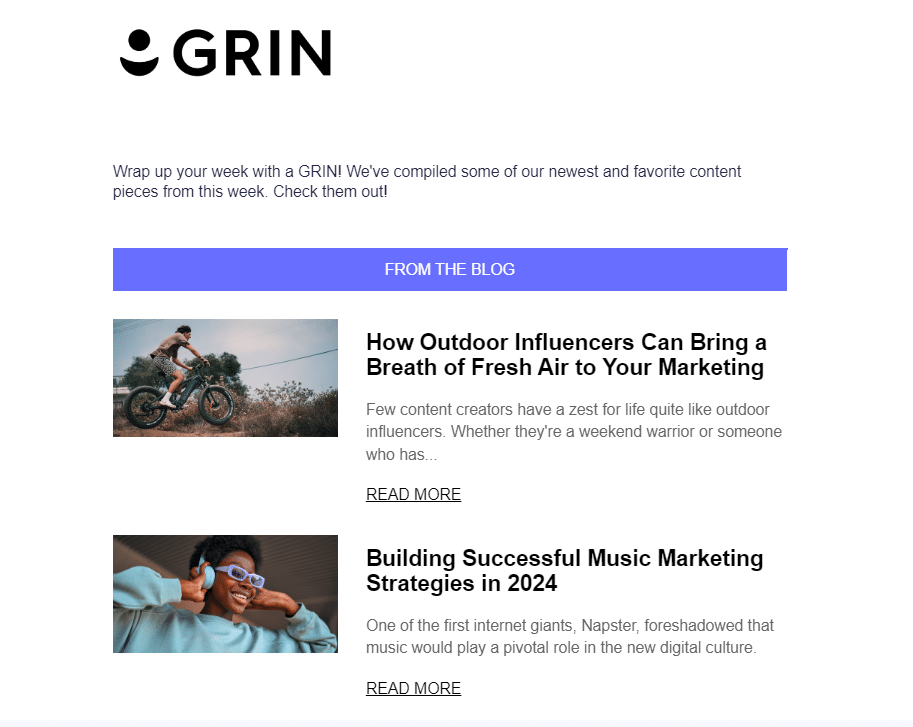
IV. Event Invitations
Send email webinar invites to leads who are interested in learning more about your industry or offerings. These events build a deeper connection and give valuable insights that can influence their buying decision.
An excellent example is the Hootsuite invitation email that clearly shows the event details and benefits. Notice how they highlight the date and time in extra-large fonts for easy reading. Plus, the “Register Now” button is prominently placed in a bold, contrasting color for better visibility.
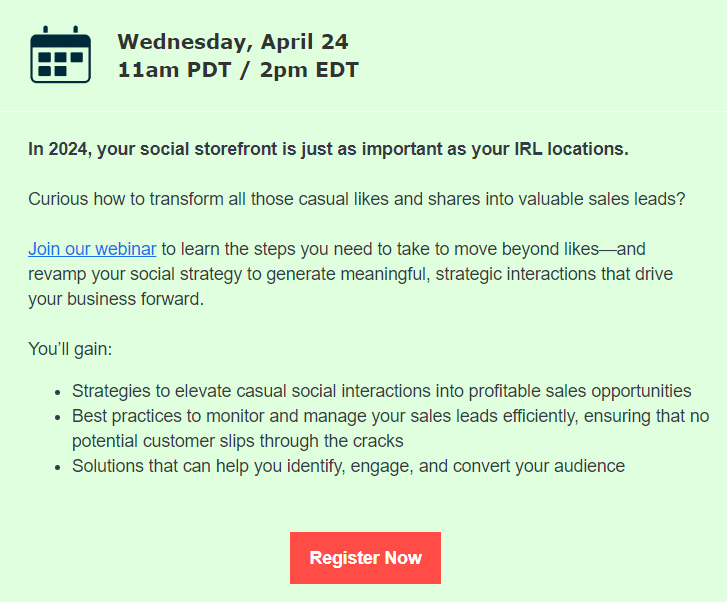
Similarly, once your recipient registers for your event, send a confirmation email. An excellent example is the registration confirmation email by AlisQI. It clearly states the event details, provides an “Add to calendar” option, and includes a “View webinar” button to let the recipient know how to join the event the easiest way possible.
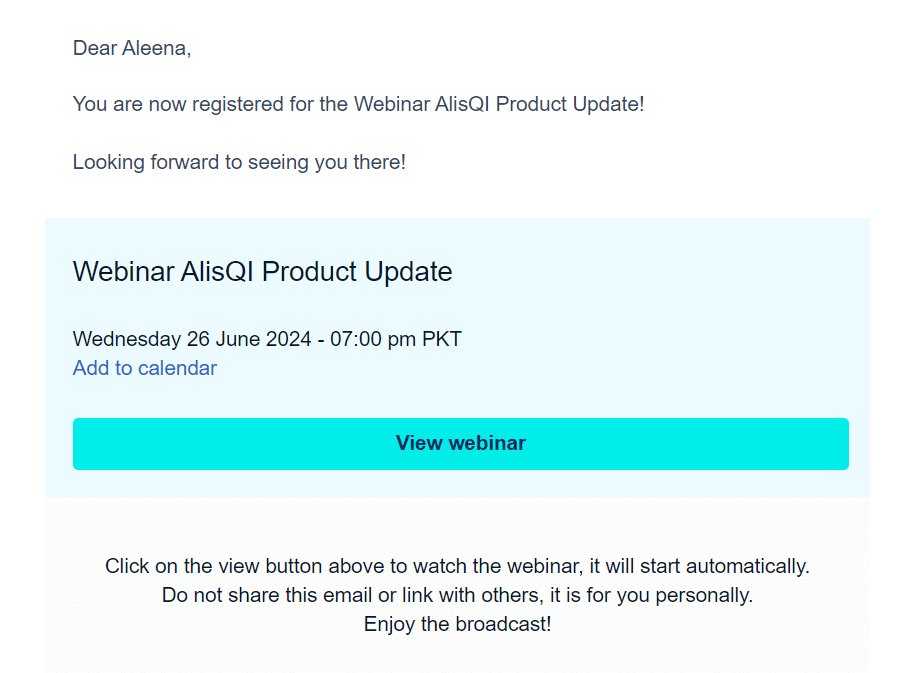
V. Follow-Up Emails
Use these in your email nurture campaign to follow up on previous interactions and keep the conversation going. Send this after a lead downloaded a resource, attended a webinar, or showed interest in your product. Mention past interactions, offer more resources, and invite leads to act.
Here’s a great follow-up email example. It keeps a friendly tone, addresses the recipient by name, and mentions past interactions. Also, notice how it restates key topics of interest so the recipient recalls the context for an instant connection.
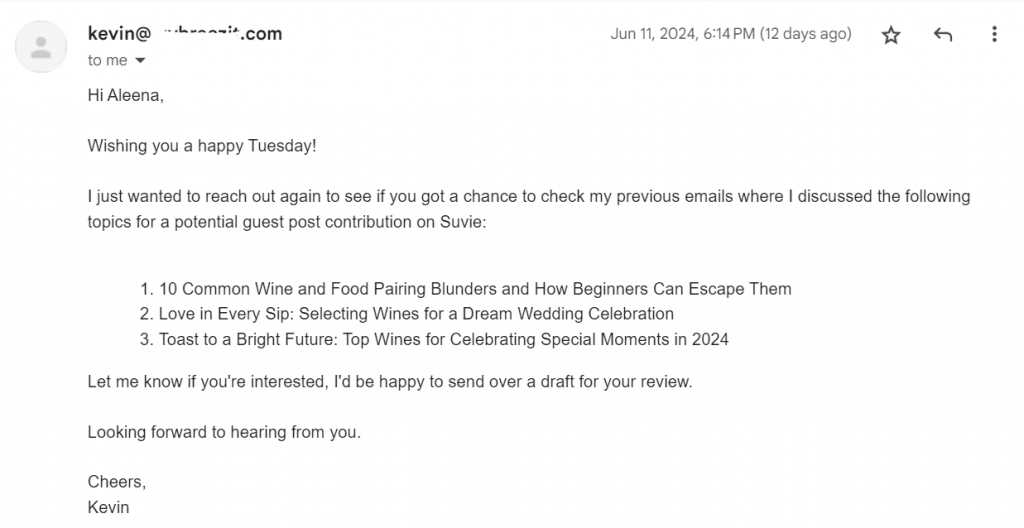
Conclusion
As you implement these strategies, keep in mind that your emails should provide valuable information that resonates with your leads on a personal level. Ask yourself: What email personalization tactics should I apply today to improve my click-through rates?
If you are looking for a tool to see better email engagement and conversions, visit Hyperise. We help you humanize your outreach across email, LinkedIn, and other social channels by adding personalized images and dynamic content. This means you can show your leads custom product mockups and relevant information that directly addresses their needs and interests.
Last Updated on July 2, 2024